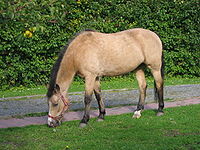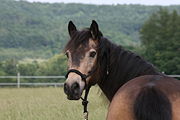.gif)
Buckskin (color)
Encyclopedia

Equine coat color
Horses exhibit a diverse array of coat colors and distinctive markings. A specialized vocabulary has evolved to describe them.While most horses remain the same color throughout life, a few, over the course of several years, will develop a different coat color from that with which they were born...
of horse
Horse
The horse is one of two extant subspecies of Equus ferus, or the wild horse. It is a single-hooved mammal belonging to the taxonomic family Equidae. The horse has evolved over the past 45 to 55 million years from a small multi-toed creature into the large, single-toed animal of today...
s; referring to a color that resembles certain shades of tanned deerskin. Similar colors in some breeds of dogs
Dog breed
Dog breeds are groups of closely related and visibly similar domestic dogs, which are all of the subspecies Canis lupus familiaris, having characteristic traits that are selected and maintained by humans, bred from a known foundation stock....
are also called buckskin. The horse has a tan or gold colored coat with black points (mane, tail, and lower legs). Buckskin occurs as a result of the cream
Cream gene
The cream gene is responsible for a number of horse coat colors. Horses that have the cream gene in addition to a base coat color that is chestnut will become palomino if they are heterozygous, having one copy of the cream gene, or cremello, if they are homozygous. Similarly, horses with a bay...
dilution gene
Dilution gene
Dilution gene is a popular term for any one of a number of genes that act to create a lighter coat color in living creatures. There are many examples of such genes:-General:...
acting on a bay horse. Therefore, a buckskin has the Extension, or "black base coat" (E) gene, the agouti gene
Agouti gene
The Agouti gene is responsible for determining whether a mammal's coat is banded or of a solid color . The chief product of the Agouti gene is Agouti signalling peptide , but there are a number of alternative splice products....
(A) gene (see bay for more on the agouti gene), which restricts the black
Black (horse)
Black is a hair coat color of horses in which the entire hair coat is black. Black is a relatively uncommon coat color, and novices frequently mistake dark chestnuts or bays for black. However, some breeds of horses, such as the Friesian horse, Murgese and Ariegeois are almost exclusively black...
base coat to the points, and one copy of the cream gene
Cream gene
The cream gene is responsible for a number of horse coat colors. Horses that have the cream gene in addition to a base coat color that is chestnut will become palomino if they are heterozygous, having one copy of the cream gene, or cremello, if they are homozygous. Similarly, horses with a bay...
, which lightens the red/brown color of the coat to a tan/gold.
Buckskins should not be confused with dun-colored horses, which have the dun dilution gene
Dun gene
The dun gene is a dilution gene that affects both red and black pigments in the coat color of a horse. The dun gene has the ability to affect the appearance of all black, bay, or chestnut -based horses to some degree by lightening the base body coat and suppressing the underlying base color to the...
, not the cream gene. Duns always have primitive markings (shoulder blade stripes, dorsal stripe, zebra stripes on legs, webbing). However, it is possible for a horse to carry both dilution genes; these are called "buckskin duns" or sometimes "dunskins." Also, bay horses without any dun gene may have a faint dorsal stripe, which sometimes is darkened in a buckskin without a dun gene being present. Additional primitive striping beyond just a dorsal stripe is a sure sign of the dun gene.
A buckskin horse can occur in any number of different breeds, though at least one parent must be from a breed that carries the dilution gene
Dilution gene
Dilution gene is a popular term for any one of a number of genes that act to create a lighter coat color in living creatures. There are many examples of such genes:-General:...
, and not all breeds do. Since 1963, the American Buckskin Registry Association has been keeping track of horses with this coat color, and although Buckskin is sometimes classified as a color breed
Color breed
A color breed is a term that refers to horses that are registered based primarily on their coat color, regardless of the horse's actual breed or breed type....
, due to its genetic makeup that depends on having one, not two copies of the dilution allele
Allele
An allele is one of two or more forms of a gene or a genetic locus . "Allel" is an abbreviation of allelomorph. Sometimes, different alleles can result in different observable phenotypic traits, such as different pigmentation...
, it cannot ever be a consistently true-breeding trait.


